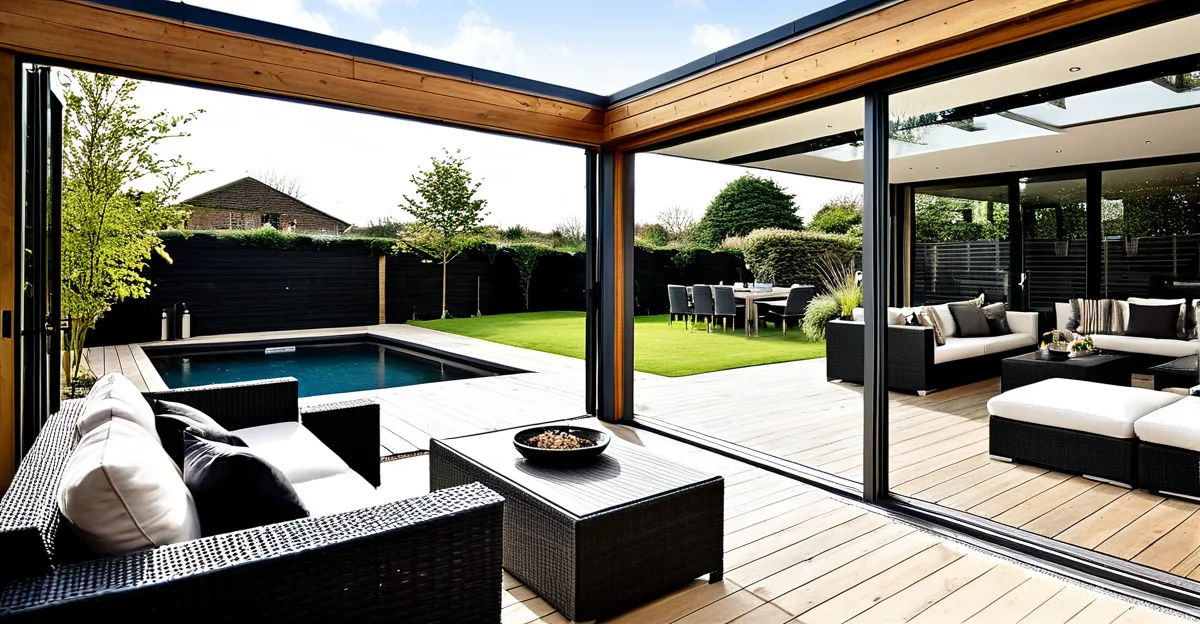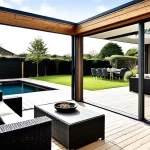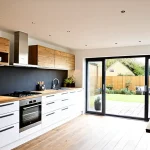Essential Design Elements for Seamless Indoor-Outdoor Living
Creating a true indoor-outdoor living design hinges on achieving both visual and physical fluidity between spaces. A cornerstone of this approach is the use of bi-fold doors, which maximize connectivity by fully opening up the boundary between the interior and exterior. These doors allow homeowners to enjoy an uninterrupted transition, fostering a sense of spaciousness and welcoming natural light into the home.
Another vital design element is maintaining flooring continuity. Selecting materials that extend from inside to outside helps blend the two areas seamlessly. For instance, using matching tiles or treated wood outdoors that mimic the interior flooring creates a cohesive aesthetic and eliminates the jarring shift typically caused by different floor surfaces. This technique is especially effective in enhancing flow in UK home design, where weather conditions demand practical yet stylish solutions.
In parallel : What are the benefits of incorporating biophilic design in UK homes?
Complementing these elements, matching colour schemes and materials across indoor and outdoor spaces strengthens unity. Harmonizing paint colours, furniture tones, and material textures ensures the design feels integrated rather than fragmented. Thoughtful coordination in this way supports not only aesthetics but also comfort, as the environment appears more inviting and well-conceived. Through these essential design choices, homeowners can enjoy seamless indoor-outdoor living that withstands the practicalities of the UK climate while elevating their everyday experience.
Weatherproofing and Climate Solutions for the UK
The UK’s variable climate necessitates thoughtful weatherproofing in indoor-outdoor living design. To withstand frequent rain and changing temperatures, homeowners must install robust doors and windows that prevent drafts and water ingress. High-quality seals on bi-fold doors are essential, ensuring they close tightly against the frame to maintain insulation and protect interiors from moisture.
Also to see : What are the best ways to create a minimalist home in the UK?
Covered shelters such as patios, awnings, or pergolas provide valuable protection, allowing outdoor spaces to remain usable throughout the year. For example, a well-designed pergola with waterproof roofing can create a sheltered extension of the home, enhancing both comfort and utility regardless of weather conditions.
Insulation plays a vital role in balancing indoor-outdoor living comfort. Beyond traditional wall and roof insulation, laminated glass or double glazing in door panels helps retain heat during colder months while still allowing abundant natural light. This technique supports energy efficiency and prevents heat loss through large glass surfaces typical of indoor-outdoor living design.
In summary, combining weatherproof doors and windows with covered outdoor shelter options alongside insulation strategies allows homeowners to enjoy seamless transitions between inside and outside. These UK climate adaptations not only enhance durability but also extend the year-round usability of both spaces, making indoor-outdoor lifestyles practical despite the region’s often unpredictable weather.
Garden Landscaping and Zoning for Indoor-Outdoor Integration
Creating a harmonious connection between indoor and outdoor spaces starts with thoughtful garden landscaping and zoning. Designing multi-functional outdoor zones that reflect indoor living areas encourages seamless flow and usability. For example, a dining area just outside the kitchen or a lounge space adjacent to the living room enhances natural transitions and makes the outdoor living experience an extension of the home.
To improve both flow and privacy in UK gardens, strategic use of plants and hardscaping plays an essential role. Plants can delineate zones subtly, providing greenery buffers that soften boundaries, while pathways and terraces crafted from durable materials create clear but inviting transitions between areas. Integrating hedges, raised beds, or low walls helps manage views and noise without creating rigid separations.
Practical pathways connecting indoor and outdoor spaces encourage easy movement and accessibility, especially important in indoor-outdoor living design where usability year-round is a priority. Non-slip, weather-resistant paving materials suited to the UK’s wetter climate ensure safety while maintaining aesthetic appeal.
By combining garden landscaping techniques with clear zoning strategies, homeowners can craft outdoor environments that naturally extend indoor functions. This approach makes every part of the home—from inside rooms to garden corners—a cohesive, welcoming whole.
Selecting Materials and Furnishings Suited to the UK
Choosing the right outdoor furniture UK and materials is crucial to ensuring longevity and comfort in an indoor-outdoor living design. Given the often wet and changeable climate, prioritising weather-resistant materials protects investments from damage caused by moisture, temperature fluctuations, and UV exposure. Materials such as treated hardwood, powder-coated metal, and synthetic rattan resist decay and retain appearance over time, making them ideal for year-round use.
When considering flooring options, durability and slip resistance are key for safety and practicality. Porcelain tiles, natural stone with a textured finish, or composite decking designed for outdoor use handle wet conditions well while maintaining aesthetic appeal. Matching these outdoor surfaces visually to interior flooring supports flooring continuity, reinforcing the seamless connection between indoor and outdoor areas.
Textiles also require careful selection. Waterproof cushions and fade-resistant fabrics ensure that outdoor furniture remains comfortable and vibrant despite exposure to rain and sunlight. Incorporating furniture with removable covers allows for easy cleaning and storage, prolonging usability throughout the year.
By integrating carefully chosen weather-resistant materials and durable furnishings suited specifically for the UK’s environment, homeowners can enjoy attractive, functional outdoor spaces that complement their indoor living areas while standing up to seasonal challenges. This approach elevates both style and practicality in indoor-outdoor living design.



